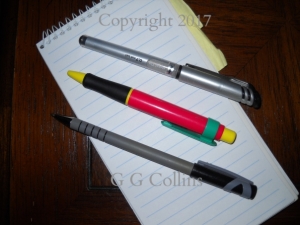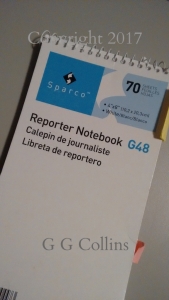Interviewing for the Fiction Writer
Posted by G G Collins
So You Have to do an Interview!
By G G Collins (Copyright 2017)
Nonfiction writers are accustomed to conducting interviews, but what about the fiction writer? It’s fiction; don’t I just make it up? Some writers may be able to, but the vast majority of us will have to do some research, including the dreaded interview.
Here’s how.
The Interview: Who You Gonna Call?
Maybe you need location information. Yes, you can Google photos and descriptions, but what if you need specific information about a festival for a scene in your book? How a rescue is performed in a national park? Background on a historical event that occurred in the 1940s? Is there seismic activity in the locale you’re using? I’ve answered all these questions for my books by doing interviews: some in person, others via phone or email. Note: If you do an email interview, be sure to tell your source if you need detailed information and ask if follow-up questions are okay.There is a wealth of experts out there who are willing to talk with you. Yeah, their boss may make them, but most of them are happy to share their knowledge. I’ve spoken to festival organizers, park rangers, historians, museum curators and university professors. Their enthusiasm for their subject or specialty is contagious. You’ll go back to your computer with lots of ideas because of what you have learned.
Decide what it is you need to know and call the city’s tourism office or chamber of commerce for referrals. Universities are great places to learn about almost anything and don’t forget area historical societies. If you have a question, there is someone who can answer it.
You may need to give them your credentials. If you haven’t published as yet tell them about your debut project, why you’re qualified to tell the story and how far along you are in writing the book. But if you aren’t published, don’t assume no one will talk with you.
The Tools: Reporter’s Notebook, Recording Device, Pens
A reporter’s notebook is thinner than other notebooks. It’s 4 inches wide which makes it faster than an old-fashioned steno pad.
Use a recording device. I still use a small cassette recorder, but there are other options now with smart phones and tablets. Use what you’re comfortable with.
A combination of notes and recording is best. What if air conditioning, nearby conversation or airplane traffic drowns out the recording? I’ve had all these happen. It’s a sinking feeling when you can’t understand the interview. You’ve got to have the notes as backup.

Which Pen Would You Choose?
When taking notes during an interview or at a press conference, the type of pen you choose can make all the difference. Look at the pens in the photo. Which would you select? The best one for taking notes while someone is talking about 110 words a minute; the round colorful one. Reason? It has a medium ball point.
The other two pens are both fine points, one is a gel tip. Fine points slow down note taking. I’ve found the gel tip to be even slower, dragging and pulling. The medium tip slides almost effortlessly. The rounded shape is more comfortable to the hand. And the rubber strip around the tip assists the fingers in grasping the pen without gripping, reducing strain. Some pens even come with built-in lights. Just be careful where you use them. You don’t want to disturb others. When I review performance art, I take notes in the dark. Yes really.
If you take shorthand or speedwriting, great, but most of us don’t. They are dying skills. If not, you can quickly develop your own with a little practice. Some words like “people” are used a lot. I shorten it to “ppl.” Leave out the vowels. To add “ent” I use a hyphen at the end of the base word: “cont-” for “content.” For “ing” I underline the last letter of the base word: “end” for “ending.” You’ll find your own way.
Questions: The Basic Six
Go to an interview with a minimum of six questions. Let’s say your protagonist is going to get lost in that national park. You’ll want to know the best way for your character to alert someone she needs help. Of course, her cell phone won’t work. Does the park require hikers to sign in and out? If so, how long does the park wait before searching? Would your character need a signal fire or other SOS? How are rescues done? By helicopter? By foot? Another way? You don’t want to say they used a vehicle if there are no autos allowed in the park at any time. Is there a famous person who was rescued at the park? What was the most difficult rescue? Anecdotes add interest.
That’s your six questions.
I add a seventh question: Is there anything I haven’t thought to ask that you think would be important for my readers to know?
What if I’m Anxious?
You probably will be the first few times you talk with someone, that’s why you should be prepared. Readiness makes for less nervousness. Writers are often life-long learners and your need to learn will likely help you relax. Greet the person as you would anyone with a handshake and a smile. Then get to business. They are making time for you and you should take only 20 to 30 minutes of the valuable time for your interview.

A Reporter Notebook is only 4 Inches Wide.
When you get to your final question, tell them it’s the last question. That way they understand you’re wrapping up.
Then thank them for taking the time to talk with you. Say goodbye and leave. Don’t linger. Your work is done. Let them get back to theirs.
It’s always nice to follow the interview with a thank you: mail, email or text. You judge which is appropriate by the age and rank of the interview. Get a business card before you leave their office so you have the contact information.
How to Use What You’ve Learned
Now that you have soaked up the knowledge of your expert, it’s time to write it down, right now, while it’s still fresh. Rough out how you want to use it. It can be blended into location description, insider information to make your prose more realistic or dialogue that adds depth and interest to your story.
You just did an interview!

About G G Collins
G G COLLINS writes to keep you awake nights. Her gutsy mystery characters go where no woman has gone before. Regardless, they always get their man--or woman. And her young adult fiction reaches right in and grabs that adolescent insecurity we all remember. For excerpts, author news, writing tips, reviews and quirky Santa Fe factoids see her websites: Reluctant Medium at Large Parallel Universe at Large Contact her via her publisher.Posted on January 8, 2017, in About, interviewing, reporting, Uncategorized, Writing and tagged Fiction, fiction authors, interviewing skills, interviews, reporter notebook, taking notes, writing. Bookmark the permalink. 10 Comments.
![By Cogiati (own work) [CC0], via Wikimedia Commons](https://reluctantmediumatlarge.files.wordpress.com/2017/01/reporting-interview-wikepedia.jpg?w=300&h=200)







Thank you for stopping by. For more info on the song: “Life is Eternal” by Carly Simon, from “Have You Seen Me Lately” album. https://www.youtube.com/watch?v=1eR1ni6sZK4 Got me through some rough times.
I was actually looking for some advice on interviewing. This is great. Thank you!!
Thank you!
Reblogged this on The Owl Lady.
My pleasure GG 😀
And thank you Chris. I appreciate the re-blog and support for writers.
You’re welcome!
Thank you very much. Several thousand times. I appreciate you taking a look.
Very useful info. The level of detail shows you’ve been there and done that.
Reblogged this on Chris The Story Reading Ape's Blog and commented:
Great advice and tips from author G G Collins 😀